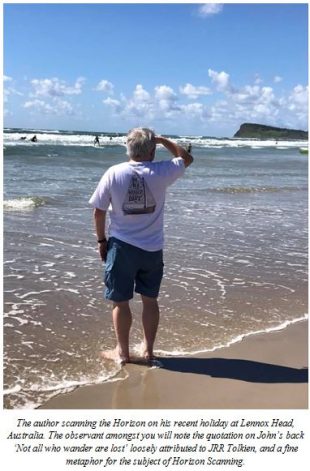
Dr John Carney, Principal Scientist within the Systems Thinking and Consulting Group of the Defence Science and Technology Laboratory (Dstl). Previous roles include Team Leader for Horizon Scanning and Dstl’s Industrial and Academic Co-ordinator.
This blog presents a candid view of the lessons learned carrying out Horizon Scanning within a UK Government Department.
Back in 2012, I gave a talk called the Ten Commandments of Horizon Scanning at the UK’s Operational Research Society. It was a personal perspective based upon my own experiences of carrying out and leading Horizon Scanning[1] activities earlier that year.
At the time, UK government led Horizon Scanning was experiencing something of a resurgence given a perception that some significant geopolitical shocks (e.g., the Arab Spring and the rapid economic rise in Asia) had not been sufficiently well anticipated. In looking back at where we had fallen short we created a set of ten commandments which have stood the test of time and cover the full gamut of purpose, communication, the scanning process itself, stakeholder engagement and impact.
- Don’t think that Horizon Scanning is about predicting the future – this is a common misconception. The value of Horizon Scanning is in using it to change mind-sets, challenge assumptions and provide more options.
- Don’t look for ‘what you know or want’ – scanning is not the same as searching. This may seem contradictory, but it is one of the hardest commandments to get your mind around as either a practitioner or a client. Horizon Scanning is more about asking the ‘unasked questions’ or identifying the “unknown unknowns” (after Donald Rumsfeld).
- Don’t negate the need for a champion or dedicated client – the major challenge for a Horizon Scanning analysis is in overcoming cultural resistance. A supportive and influential stakeholder is a great help – but choose wisely (if you can) and manage expectations accordingly.
- Don’t forget to sustain the evidence base – a systematic and comprehensive scanning process provides a degree of (scientific) robustness which is important for credibility.
- Don’t think that there is any consistent understanding of what Horizon Scanning is about – there is a lack of a common understanding within the Horizon Scanning and Futures community and a common language. The various disciplines that have contributed to Horizon Scanning have resulted in a variety of views of what it is. Furthermore, the inconsistency of application means the term Horizon Scanning is widely used and, in many cases, misused. You should define your terms and meanings.
- Don’t be afraid to challenge your own way of doing things – there is no magic (or agreed) recipe for how to do Horizon Scanning but watch out for thinking that the way that you do it is the best and only way. Asking other teams to review your work is a great way to introduce new approaches and views to your Horizon Scanning activities.
- Don’t forget ‘the team’ – use a dedicated cadre of ‘generalists’, ideally recruited from very different academic backgrounds (including the arts and the sciences). Consider the wider team too. Externals to your own area or consultants can often present an uncomfortable conclusion more effectively.
- Don’t negate the need for impact – Focus on describing the implications of your analysis (the ‘so what’) rather than the process or detailed content. Also remember that uncertainty and risk (or opportunity) are not the same thing.
- Don’t expect to be thanked or enjoy it too much – Horizon Scanning is a challenge function and at times you may feel like you are in the front-line of a war zone. The most important contribution a futures project makes is likely to be an invisible one
- Don’t give up the day job – for some, Horizon Scanning may become a full-time or even life-long profession, but for most it can be a useful adjunct to a more mainstream activity. Be wary that Horizon Scanning can at times seem like a cult but treat it not as a single bullet but one tool useful of many in the Futures armoury.
I am very grateful to the UK government’s Horizon Scanning Community and members of the Dstl Horizon Scanning Team for providing the stimulus for this paper and post.
Call to action
Please comment if you agree or disagree with any of the commandments or better still add your own. If you would like a copy of the full paper or hear the presentation from the ‘horses mouth’ please contact the author at jcarney@dstl.gov.uk . If you wish to learn more about the art of HS then come along to one of the Heads of Horizon Scanning meetings run by GO-Science and/ or join up to the Dstl’s Futures Community of Practice.
[1] For a description of Horizon Scanning please see GO-Science’s Futures Toolkit (link).
1 comment
Comment by KC Gustafson posted on
A super blog post! A very helpful crib-sheet. Perhaps the start of a "Quick Wins for Busy Horizon-Scanners"?